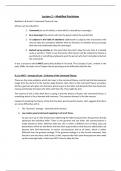Lecture 2 – Modified Positivism
Bentham’s & Austin’s Command Theory of Law:
All laws can be reduced to:
1. Command (an act of volition, a wish which is uttered by a sovereign)
2. By a Sovereign (the person who has the power within the jurisdiction)
3. To subjects in the habit of obedience (addressed to subjects who are persons who
have to obey the command, whether they are forced to or whether they just accept
that they must habitually obey the sovereign)
4. Backed up by sanction (in the event that they don't obey the rule, then it is backed
up by a sanction. That's to say that some other person will be required to impose a
punishment or something unpleasant upon the person who hasn't actually carried out
the command)
It was a structure which HART particularly disliked in his book ‘The Concept of Law’, written in the
early 1960s. He starts out in Chapter two by pointing out the difficulties that this has.
H.L.A. HART – Concept of Law – Criticisms of the Command Theory:
These are the main problems which Hart sees in the command theory, and to help him borrowing an
image from the work of in the Austrian legal theorist, Hart refers to the command theory as being a
bit like a gunman who goes into the bank, points a gun at the teller and demands that they hand over
money and thereby threatens the teller with their life. They might be shot.
The essence of this is that what Hart is saying is that the theory of Austin, the command theory, is
something which is like a demand with menaces. The sanction element is like the menace.
Instead of accepting the theory of law that has been put forward by Austin, Hart suggests that there
are some difficulties with it.
• The “Gunman” analogy – demands with menaces
1. Law makes general demands applying to all at all times.
So you can't say it's like the gunman addressing the teller because there the gunman directly
addresses the individual teller. There is one gunman and one teller, the communication is
made directly to them. Whereas with law, this is rather a different sort of thing. Laws are
declarations which are laid down and they have a generality in that they are addressed to all
persons who find themselves in certain circumstances and at all times, which is rather
different than the gunman analogy. If the gunman analogy is a one-to-one command, then
the law is one too many. And it even, in fact, imposes the rules upon those persons who make
up the sovereign body so that even MP’s have to obey the law.
, 2. Many laws do not impose duties but give opportunities, empower people to do legal acts to
harness the law for their own purposes.
Law is a structure which gives meaning and value to people's lives and enables them to
harness its powers so that people can enter into contracts with each other. They can get
married, create a will, and regulate their affairs, how they're to be dealt with after their death.
So it's not as if the image of the sanction in the command theory is always going to be
appropriate.
3. Much law comes from custom and not from a sovereign
If we look at Scots law, we find that both in the civil law and the criminal law, there are
institutional writers who have laid out a rational view of what things ought to be. And in many
cases, quite a lot of the laws derive in an amended form from the Roman law upon which
Scots law is ultimately based. But even apart from that, there are lots of areas of business
practise which have been built up over the centuries and which have been enshrined into law.
So, it certainly is not the case that sovereign powers, whether king or queen or whether a
parliament has actually considered all the various areas that we regulate law over. Instead,
the law has developed dynamically, and a great deal has come from custom.
4. How can one sovereign succeed from another?
For when one sovereign king or queen dies, it doesn't follow that all the laws that they have
built up suddenly corrupt more to the ground with no further effect, quite apart from the law,
does seem to continue to exist. And yet this is not what we would expect in the case of a
command being made. But if it were the command, if the gunman in the example we've given,
where suddenly to have a heart attack and die, then the teller would feel under no obligation
to hand over money to anybody. So there are clearly some problems with Austin's theory and
Hart starts these with these criticisms to show that these problems exist.
H.L.A. HART – Concept of Law – preface:
In the preface to the Concept of Law, Hart actually gives an indication of the kind of theory that he's
eventually going to start with:
““The most prominent general feature of law at all times and places is that its existence means that
certain kinds of human conduct are no longer optional but in some sense obligatory” but he himself
hopes to provide “an improved analysis of the distinctive structure of a municipal legal system and a
better understanding of the resemblances and differences between law, coercion, morality, as types
of social phenomenon.”
He does have here four distinct ideas which are vitally important, as he is saying, for the definition of
any system of law. And these are laws as rules and the law as a set of rules. So he's obviously going to
be discussing what rules are and basing his idea of law upon the idea of a system of rules. Secondly,
‘coercion’ that is having certain powers to inflict pain or violence or unpleasant consequences upon
people. Thirdly, ‘morality’ for a legal system ought to be a constructive thing and socially useful. So, it
is likely to have moral principles. And fourthly, he says that laws are types of ‘social phenomenon’. So,
we shouldn't forget that there are social aspects of what is going on. A system of law is a social
phenomenon with social utility, ti has purposes in regulating a society. So, these four things laws, a





